Lessico
Lentisco
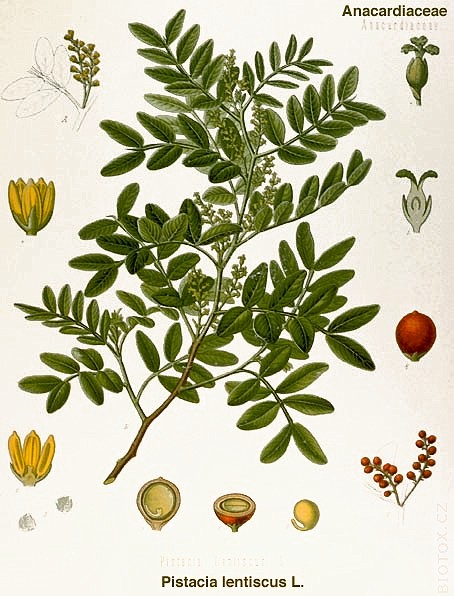
Lentisco o lentischio, Pistacia lentiscus: pianta sempreverde della famiglia Anacardiacee propria delle regioni più calde del Mediterraneo, dove partecipa alla formazione della macchia. È un piccolo arbusto aromatico con foglie fitte, paripennate, coriacee, a picciolo alato; i fiori sono dioici, piccoli, rossastri, privi di petali, in racemi; i frutti sono minuscole drupe sferiche prima rosse e poi nere.
Il lentisco fornisce una resina (resina mastice, dal greco masticháein = digrignare i denti) usata un tempo nella preparazione di mastici dentari. Gli impieghi attuali della resina vanno dalla profumeria all'odontotecnica (appunto come componente di paste per le otturazioni e mastici per le dentiere). È anche impiegata come componente nella produzione del chewing gum.
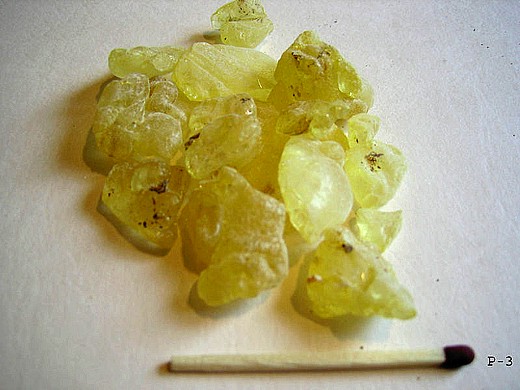
La resina si può estrarre praticando incisioni sul fusto e sui rami in piena estate e raccogliendola dopo che si è rappresa all'aria. Si sottopone a lavaggio per eliminare le impurità e si conserva dopo essiccazione in contenitori di legno. In passato i frutti venivano sottoposti a bollitura e a spremitura per estrarre un olio impiegato come combustibile per l'illuminazione e come succedaneo dell'olio d'oliva per l'alimentazione.
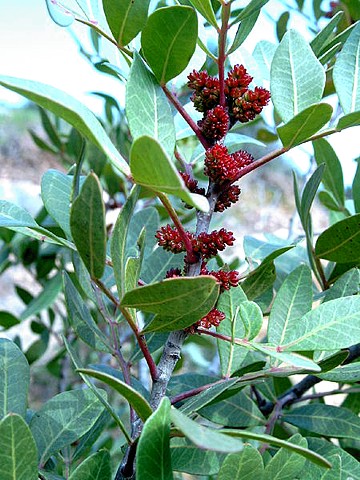
Mastic
(Pistacia lentiscus) is an evergreen shrub or small tree of the
Pistacio family growing up to 4 m (13 ft) tall, which is cultivated for its
aromatic resin on the Greek island of Chios![]() . It is
native throughout the Mediterranean region, from Morocco and Iberia in the
west through southern France and Turkey to Syria and Israel in the east; it is
also native on the Canary Islands. The word mastic derives either from a
Phoenician word or from the Greek verb masticháein ("to gnash the
teeth", origin of the English word masticate) or massein ("to chew").
. It is
native throughout the Mediterranean region, from Morocco and Iberia in the
west through southern France and Turkey to Syria and Israel in the east; it is
also native on the Canary Islands. The word mastic derives either from a
Phoenician word or from the Greek verb masticháein ("to gnash the
teeth", origin of the English word masticate) or massein ("to chew").
For reasons that are not entirely understood, only the trees in the southern part of the island of Chios produce the distinctively flavoured resin. The island's mastic production is controlled by a co-operative of medieval villages, collectively known as the 'Mastichohoria', which are also located in the southern part of Chios.
Within the European Union, Mastic spice production in Chios is granted protected designation of origin (PDO) and a protected geographical indication (PGI) name.
Resin
The aromatic, ivory coloured resin, also known as mastic (or mastix), is harvested as a spice from the cultivated mastic trees grown in the south of the Greek island of Chios in the Aegean Sea, where it is also known by the name "Chios Tears". Originally liquid, it is sun dried into drops of hard, brittle, translucent resin. When chewed, the resin softens and becomes a bright white and opaque gum.
Cultivation history
The resin is collected by bleeding the trees from small cuts made in the bark of the main branches, and allowing the sap to drip onto the specially prepared ground below. The harvesting is done during the summer months between June and September. After the mastic is collected it is washed manually and spread in the sun to dry.
Mastic shrub
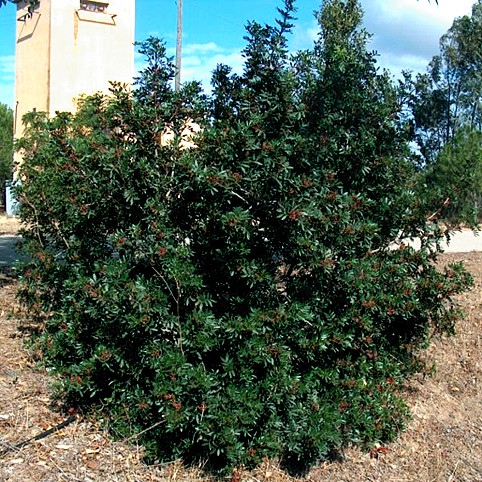
Mastic
resin is a relatively expensive kind of spice, that has been used, principally,
as a chewing gum, for at least 2,400 years. The flavour can be described as a
strong slightly smoky, resiny aroma and can be an acquired taste.
It is known to have been popular in Roman times when children chewed it, and
in Medieval times it was highly prized for the Sultan's harem both as a breath
freshener and for cosmetics. It was the Sultan's privilege to chew mastic, and
it was considered to have healing properties. The spice's use was widened when
Chios became part of the Ottoman Empire, and it remains popular in North
Africa and the Near East.
Within the European Union, Chios Mastic production is granted protected designation of origin (PDO) and a protected geographical indication (PGI) name.[6] The 'Mastichohoria' (mastic-producing villages) are located in the southern part of Chios.
Culinary uses
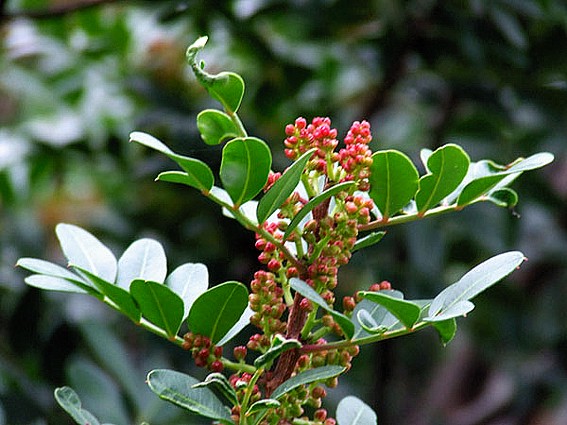
Mastic gum is principally used either as a flavouring or for its gum properties, as in mastic chewing gum. As a spice, it continues to be used in Greece to flavour spirits and liquors (such as Chios's native drinks of Mastichato & mastica), chewing gum and a number of cakes, pastries, spoon sweets and desserts. Mastic resin is a key ingredient in Dondurma (Turkish ice cream), and Turkish puddings granting those confections its unusual texture and bright whiteness. In Lebanon and Egypt, the spice is used to flavour many sauces, ranging from soups to meats to desserts, while in Morocco smoke from the resin is used to flavour water. Recently, a Mastic flavoured fizzy drink has also been launched.
As well as its culinary uses, Mastic continues to be used for its gum and medicinal properties. The resin is used as a primary ingredient in the production of cosmetics such as toothpaste, lotions for the hair and skin, and perfumes.
Mastic resin
Mastic
resin is also chewed as a gum to soothe the stomach. People in the
Mediterranean region have used mastic as a medicine for gastrointestinal
ailments for several thousand years. The first century Greek physician and
botanist, Dioscorides![]() , wrote
about the medicinal properties of mastic in his classic treatise De Materia
Medica ("About Medical Substances"). Some centuries later
Markellos Empeirikos
, wrote
about the medicinal properties of mastic in his classic treatise De Materia
Medica ("About Medical Substances"). Some centuries later
Markellos Empeirikos![]() and
Pavlos Eginitis
and
Pavlos Eginitis![]() also
noticed the effect of mastic on the digestive system.
also
noticed the effect of mastic on the digestive system.
In recent years, university researchers have provided the scientific evidence for the medicinal properties of mastic. A 1985 study by the University of Thessaloniki and by the Meikai University discovered that mastic can reduce bacterial plaque in the mouth by 41.5 percent. A 1998 study by the University of Athens found that mastic oil has antibacterial and anti-fungal properties. Another 1998 University of Nottingham study, published in the New England Journal of Medicine, claims that mastic can heal peptic ulcers by killing Helicobacter pylori, which causes peptic ulcers, gastritis, and duodenitis. However, a more recent study from 2003 shows that mastic gum has no effect on Helicobacter pylori. Another research from 2003 also shows similar findings.
Other uses
Apart from its medicinal properties, cosmetics and culinary uses, Mastic gum is also used in the production of high grade varnish. The Mastic tree has been introduced into Mexico as an ornamental plant, where it is very prized and fully naturalized. The trees are grown mainly in suburban areas in semi-arid zones and remain undamaged although the regime of summer rainfall is contrary to its original Mediterranean climate.